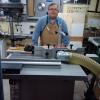I'm attempting my first panel door and have been practicing with my rail and style bits. The problem I am having is that I keep gouging the edges until my wood hits the bearing. It is not so bad with the inside because my fence helps me with the long pieces. However, with the narrow ends it is a real problem. What is the proper way to feed the ends into the bit so I do not gouge the edges?
I recently built a router table and the recommendation was not to install a T-slot because using a miter gauge was not necessary on a router. Now I'm thinking this guy never did rails & styles because I can't think of any other way to do it.
Thanks.




 Reply With Quote
Reply With Quote






